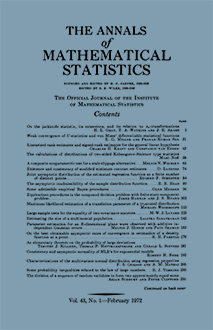Abstract
It is well known that the future life distribution of a device remains the same regardless of the time it was previously in use, if and only if the life distribution of that device is exponential. For this reason exponential life distributions are accepted as characterizing the phenomenon of no wear. The problem of finding a class of life distributions which would similarly reflect the phenomenon of wear-out has been under investigation for some time. In answer to this problem we introduce in this paper the class of IHRA (Increasing Hazard Rate Average) distributions and show that it has, among others, the following optimal properties: (i) it contains the limiting case of no wear, i.e., all exponential distributions, (ii) whenever components which have IHRA life distributions are put together into a coherent system, this system again has an IHRA life distribution, i.e., a system wears out when its components wear out, and (iii) the IHRA class is the smallest class with properties (i) and (ii).
Citation
Z. W. Birnbaum. J. D. Esary. A. W. Marshall. "A Stochastic Characterization of Wear-out for Components and Systems." Ann. Math. Statist. 37 (4) 816 - 825, August, 1966. https://doi.org/10.1214/aoms/1177699362
Information





